Monthly Archives: April 2013
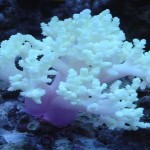
Colt Coral
Scientific Name: Cladiella SP
Common Name: Colt Coral, Cauliflower Corals.
Type of Coral: Softie
Lighting: Moderate and Moderate to Low
Flow: Moderate and moderate to high
Care Level: Easy
Temperament: Semi-aggressive
Appearance
Generally speaking, leather corals are a soft skinned coral with visible polyps all over their skin. A leather coral can look one way in a aquarium and then (over time) look very different when placed in another tank based only on the water parameters, lighting and flow.
Colt Corals can look similar to a finger coral, but the shape of the polyps and the tips of the fingers make it look more like cauliflower. They will more commonly range in color from a brownish red to a light pink with the polyps a little brighter color than the base. They don’t get quite as big as a finger leather but will still need 12 to 14 inches of space in your tank based on its size potential and growth rates.
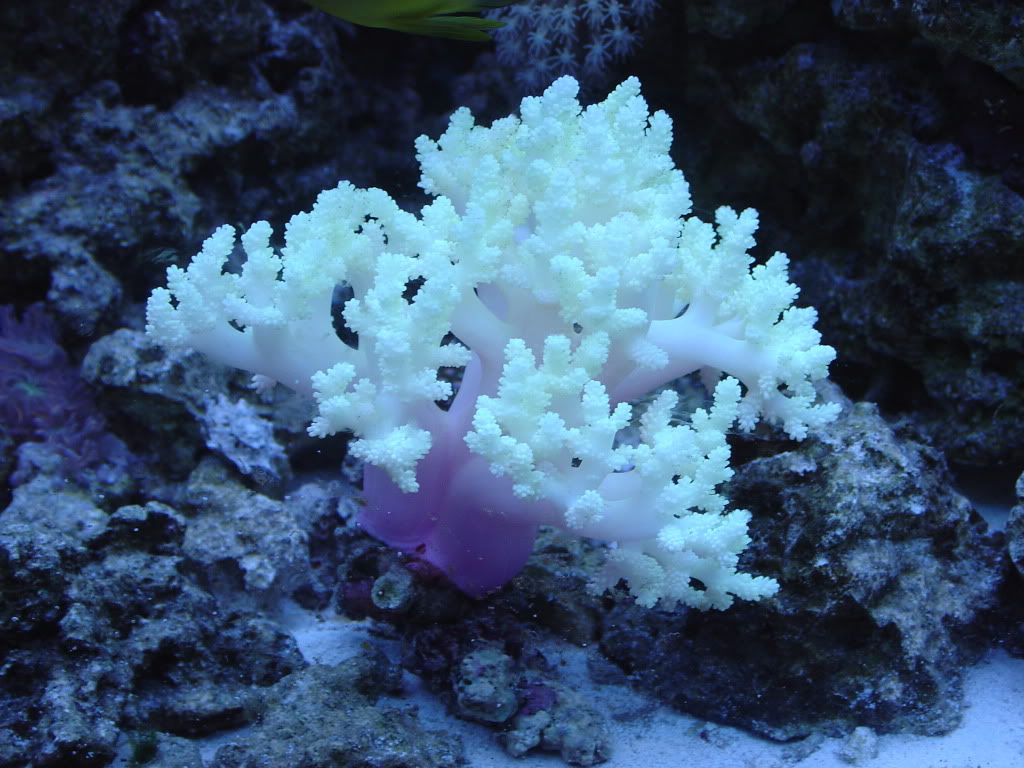

Water Conditions
The below link highlights typical water conditions this leather coral will require. I have had the best luck when they were kept in water with 1 to 2 ppm of nitrate when lighting and flow requirements were met and all other water parameters in line as described in the below link.
https://www.reefaquarium.com/2013/the-basics-of-marine-aquarium-water-parameters/
General Information
As they do not have a calcified skeleton structure making them a little more tolerant of some water parameters like calcium. However, they will not be very tolerance to swings in pH, Temp, or salinity which is no different than any other coral or fish. They are a very hardly coral making them a good choice for people new to the hobby. Most leathers have some very effective defensive abilities. Leathers commonly have the ability to sting other corals and some fish along with emitting chemicals to ward off other corals from entering their space. For this reason it is very important to understand how big your leather coral can get and plan for enough space between your leather coral and other corals. Just leaving a few inches may not always be enough as some leathers can get surprisingly large. It would also be a good idea to have some carbon in your set-up in case your leather will start to emit defensive chemicals. This is one coral that will be the least likely to be picked on by most fish in the hobby.
As with all corals, the exterior slime coating can be a skin irritant or even highly toxic to humans so please, handle all corals with care. I would recommend wearing rubber glove whenever you handle corals
Fragging
This leather can be easily fragged with very high success
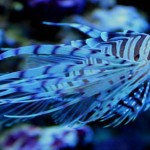
Russels Lionfish
The below Lionfish profile is based on what I have learned and observed about the Russels Lionfish. They certainly are beautiful fish to keep and will add a lot of interesting viewing pleasure to any aquarium.
Common Name: Russel’s Lionfish, Red Volitan Lionfish, Soldier Lionfish,
Scientific Name: Pterois russelii
Reef Safe: Yes
Temperament: Predator, but peaceful in the right set-up
Care Level: Moderate
Max Size: 8 to 10 inches (refers to the body size excluding the fins)
Appearance:
This is one of smaller of the larger bodied lionfish. They have all the typical fins as with any of the larger lionfish. The coloring of their stripes will be red to brown in color. It can be easy to mistake a Russels Lionfish with other larger bodied lionfish if you do not know what to look for. There are three key differences to look for. 1) The tailfin will not have any spots on it as other large bodied lionfish will have. 2) The Russels bottom jaw and chin will also be white which is another difference from the other larger bodied lionfish. And finally 3) The spins along the dorsal, pectoral and anal fins are not banded and more fleshly than other lionfish.
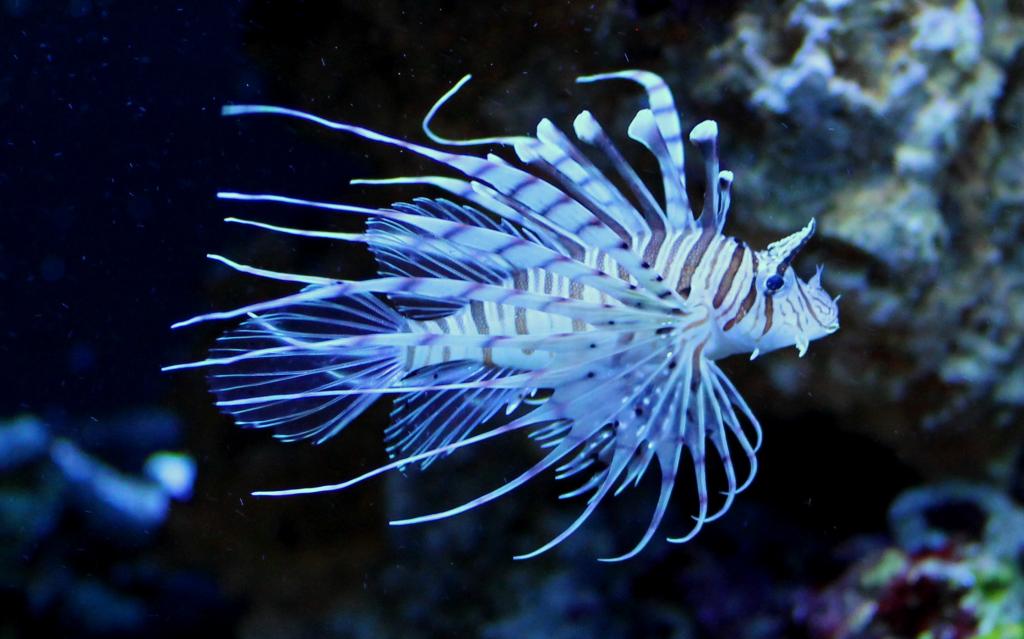
Temperament
They will do perfectly fine with other fish of similar size and can be a very peaceful community fish when kept with the correct tankmates. However, when kept with fish that have a body of about ½ of the lionfish’s body size; it will only be a matter of time before the lionfish will try to eat it. They are among the better predators common in the hobby. Although you can keep multiple Lionfish in the same aquarium, you should use caution when doing so. You would need to ensure they are bith a very similar size and added at the same time to increase your chances of success. One of the Lionfish can become very dominant and will bully the others steeling all the food when you feed the tank
Environment
I would suggest a 90 gallon aquarium would be the minimum size for a single Russels. The need swimming space both around rocks and out in the open. The do best when provided shelf like structured that they can hang up-side from as well as cave structures they can sit in. The below is an example of both. Lionfish can be kept with corals.
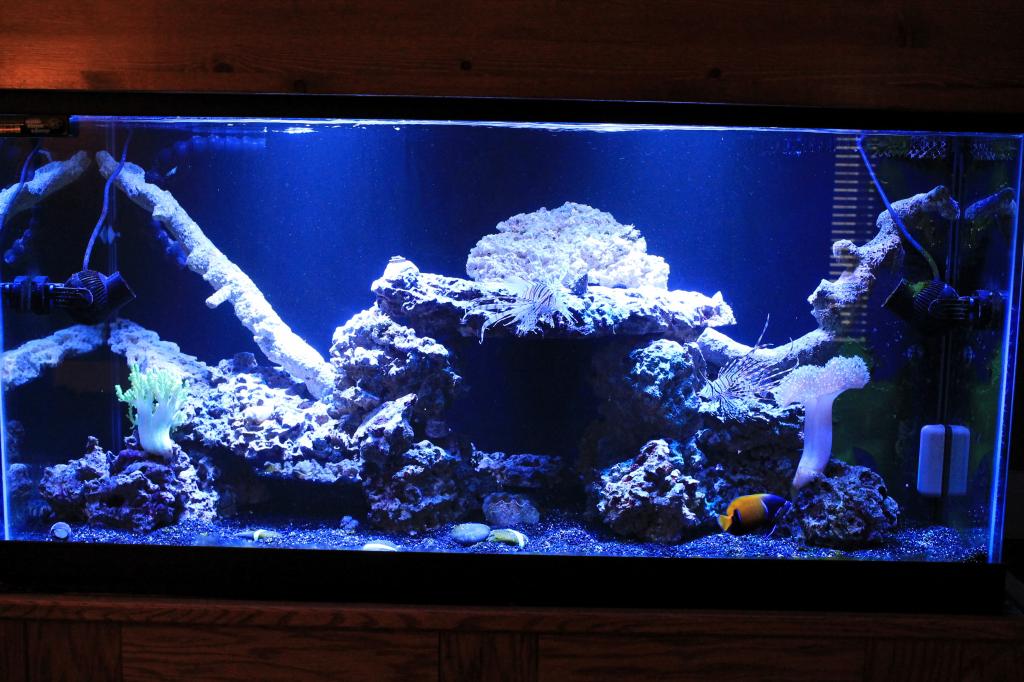
Recommended water conditions:
I would refer you to the below article for the typical water conditions that a Russel’s Lionfish will do best in:
https://www.reefaquarium.com/2013/the-basics-of-marine-aquarium-water-parameters/
Diet
Getting this Lionfish to eat a healthy diet for it’s long term health is one of the biggest reasons for hobbyist having difficulties keeping lionfish. As the lionfish is a predator, they are used to eating live fish that are anywhere about ½ their body size or less. It can be difficult to get them to switch to eating meaty frozen foods and/or pellets for marine carnivores
I have had great success by using a very long pair of tweezers to take a smaller and longer peace of frozen food and wiggling it in the aquarium near the lionfish. This makes it look alive and the lionfish will typically eat it after a few days to a week of trying. Other hobbyist has also had great success with this approach by sticking the food on a small wood stick (like you use to make shish kabob). Once they are eating the wiggling food and have gotten used to it, I will start to wiggle the food less and less slowly getting them used to eating food that doesn’t look alive. Once they are at this point, you can just add the food to the tank and they will “hunt” it down and eat it. This is why I always suggest buying a lionfish that is already eating frozen foods so the above process will be a lot easier for you.
The above process is a proven one that works. Many people get frustrated and give up trying only to offer the lionfish live foods like feeder goldfish. I do not recommend feeding your lionfish feeder goldfish for two reasons; 1) freshwater fish to not have the same mineral and fatty tissues that marine fish have which will not provide the lionfish with the proper nutrients it will need for long-term health, and 2) The lionfish will always favor live food over frozen as that is instinctive to them. This will set-back your efforts to get the lionfish to eat frozen foods. I would not even offer a lionfish live foods as the occasional treat.
Once you get your lionfish eating frozen foods, they will need a variety of different meaty foods like: prawns, large Mysis shrimp. The below thread will give you some better ideas for feeding a lionfish a diet that will help them have along and healthy life in your tank.
https://www.reefaquarium.com/2012/feeding-high-quality-froozen-foods/
Be careful not to overfeed a lionfish as they have been known to overeat to the point of creating an internal blockage if given the chance. Just feed enough until you see a slight bulge in their stomach. Feed every second day as juveniles and about three times a week as adults.
Special considerations
1) Feeding by hand
I never recommend feeding your lionfish by hand. Although they will readily take the food form you, over time they will learn to associate your hand with feeding. When you try to put your hands in the tank for reasons other than feeding, the lionfish will still think they are about to get fed and swim up very close to your hand. That can put you at some risk of getting bit or stung depending on the exact personality of your lionfish
2) Venomous Spins
The long dorsal fin of the lionfish contains venomous spins. If you get stung by one, it is going the hurt a lot like a very bad bee sting, or at least that is what I have heard. If you get stung by one, soak the stung part in hot water (as hot as you can stand it) for about 15 or 20 minutes. If you see any signs of a allergic reaction, seek medical attention immediately. I have found the best way not to get stung (accidently or otherwise) is to make sure you do not spook or corner the lionfish when you put your hands in the tank.
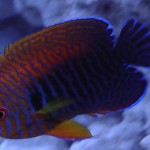
Potter’s Angelfish
Common Name: Potter’s Angelfish, Potter’s Dwarf Angelfish
Scientific Name: Centropyge Potteri
Reef Safe: With Caution
Temperament: Semi-aggressive
Care Level: Moderate
Max Size: 4 to 5 inches
Appearance:
The potter’s angelfish is a very nice looking dwarf angelfish which is what attracts many hobbyists to keeping them. Its body is a very vibrant orange color that has dark blue coloring running along the body as well with a grey to silver colored line pattern overtop. The fins are typically a dark blue color with a slightly lighter blue edge.

Temperament
This fish may sometimes be aggressive to smaller fish or fish with similar appearance and coloring. I would not recommend keeping a potter’s angelfish with another potter’s angelfish or any other dwarf angelfish as that will result in territorial behaviors and aggression. These fish do best when they are the only dwarf angelfish in the aquarium. Adding the potter’s angelfish last to your set-up will also help to reduce the risks of aggression.
Environment
The potter’s angelfish is a very active fish that would need at least a 55 gallon tank with live rock that provides multiple hiding spots for the potter’s angelfish to go to when it feels threatened. A 75 gallon aquarium would be a lot better for this fish. They will also need to be placed in a mature set-up as they need lots of live rock to pick at. Use caution and carful observation when adding this fish to a reef set-up. Some of them have been known to nip at soft corals (like zoas) and some LPS corals with soft outer tissues (like brain and donut corals). This risk can also be reduced when the potter’s angel is added to a mature set-up with different types of algaes for the fish to pick at and eat.
Recommended water conditions:
I would refer you to the below article for the typical water conditions that a potter’s angelfish will do best in. As with most fish that are moderately hard to keep, you must provide good and stable water conditions for their long-term health.
https://www.reefaquarium.com/2013/the-basics-of-marine-aquarium-water-parameters/
Diet
The potter’s angelfish is an omnivore. They will do best when offer a variety of meaty foods as well as marine algaes. Marine flakes or pellets made from marine algaes are also good foods to offer. Feeding the potter’s angelfish prepared foods for marine angelfish will also benefit them. They will also spend most of their days picking at the live rock in the tank eating different types of algaes as well as pods and other little critters that develop in a mature set-up.

Six Line Wrasse
Common Name: Six Line Wrasse, Sixstripe Wrasse
Scientific Name: Pseudocheilinus Hexataenia
Reef Safe: Yes
Temperament: Peaceful
Care Level: Easy
Max Size: 2 to 3 inches
Appearance:
This is another colorful wrasse. They have a purple coloring to their bodies with six orange colored horizontal lines running the full length of their body. They will also have stripes of a white to yellow or gold coloring running across both eyes. The dorsal fin will typically have some orange coloring on it and the tail find will have some green coloring on it.

Temperament
This is a very peaceful fish when kept with other peaceful fish. The sixline should be the last fish added to the aquarium to greatly reduce any chances of aggression. They should be the only six line wrasse in the aquarium as they will get very aggressive toward other six line wrasses in most situations.
Environment
As this is a very small fish, it can be kept in an aquarium as small as 20 gallons provided there is a lot of live rock while still leaving a far amount of swimming space within the tank. They do best with live rock as they like to scavenge for food in the rocks as well as hid in the rocks when they feel threatened. They have also been known to eat a lot of aquarium pests such as certain types of flat worms. You should also have a few inches of substrate on the bottom of the tank as this fish will sometimes burry itself into the substrate in order to hide when it feels stressed.
Recommended water conditions:
I would refer you to the below article for the typical water conditions this wrasse will do best in:
https://www.reefaquarium.com/2013/the-basics-of-marine-aquarium-water-parameters/
Diet:
As with most wrasses, they are carnivores. They will do best when offered a variety of different meaty foods along with marine flake or pellet foods meant for carnivores.
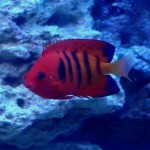
Dwarf Flame Angelfish
The below Dwarf Flame Angelfish profile is based on what I have learned and observed. They certainly are very colorful fish to keep and will add a lot of viewing pleasure to a properly set-up aquarium.